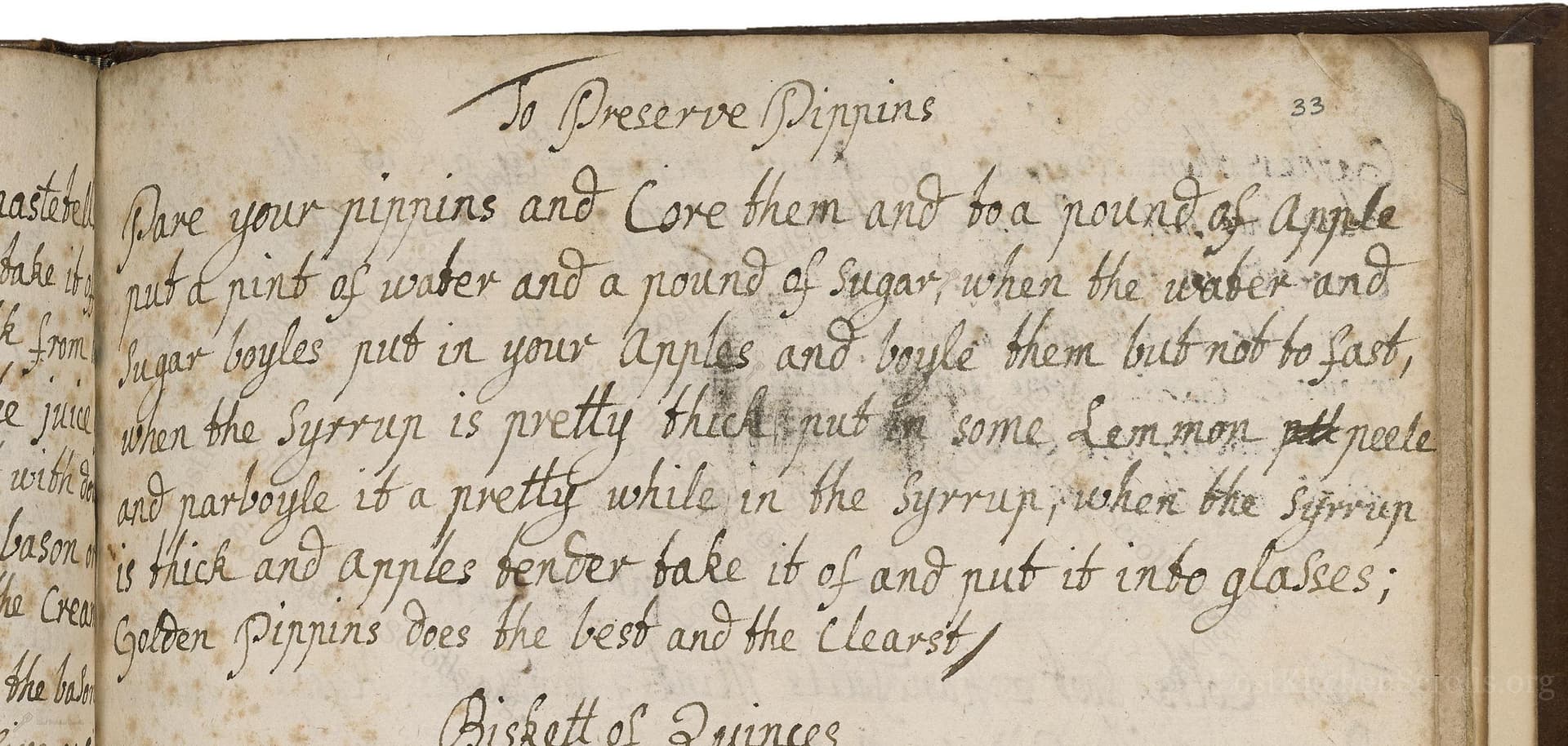To Preserve Pippins
From the treasured pages of Receipt book
Unknown Author

To Preserve Pippins
"Pare your pippins and Core them and to a pound of apple put a pint of water and a pound of sugar, when the water and sugar boyles put in your Apples and boyle them but not to fast, when the syrrup is pretty thick put in some Lemmon peele and parboyle it a pretty while in the syrrup, when the syrrup is thick and apples tender take it of and put it into glasses; Golden Pippins does the best and the Clearest/"
Note on the Original Text
The recipe is written in the imperative style typical of the time—direct and practical, assuming the reader had some kitchen experience. Measurements are by weight (pounds and pints), and spelling is variable ('pare', 'boyles', 'syrrup'), reflecting the less standardized language of the era. Instructions emphasize observation (when syrup is 'pretty thick', apples 'tender'), relying on the cook's sense and judgment.

Title
Receipt book (1700)
You can also click the book image above to peruse the original tome
Writer
Unknown
Era
1700
Publisher
Unknown
Background
A delightful glimpse into the kitchens of the early 18th century, this historic culinary manuscript promises a feast of recipes, remedies, and perhaps a pinch of mystery. Expect both practical fare and elegant inspiration for the curious cook.
Kindly made available by
Folger Shakespeare Library
This recipe dates from around 1700 and comes from an English household manuscript. Preserved fruits like these were a luxurious delight at the early modern table, both a showcase for elegant glasswork and a way to enjoy the taste of autumn well into winter. Golden Pippins—now rare—were prized for their clarity and flavor in preserves. Such recipes were both displays of skill and means of extending the season's bounty when fresh fruit was scarce.

Historically, cooks used large brass or copper preserving pans set over an open hearth or a charcoal brazier. Apples were peeled and cored by hand with small, sharp knives. Preserves were stored in tall glass 'glasses' or stoneware jars, sometimes sealed with paper or wax. Stirring was done with wooden spoons, and straining for clarity might involve linen cloths.
Prep Time
15 mins
Cook Time
30 mins
Servings
6
We've done our best to adapt this historical recipe for modern kitchens, but some details may still need refinement. We warmly welcome feedback from fellow cooks and culinary historians — your insights support the entire community!
Ingredients
- 1 pound pippins (or Granny Smith apples), peeled and cored
- 1 pound granulated sugar
- 2 cups water
- Lemon peel (from 1/2 a lemon, peeled in strips)
Instructions
- Peel and core your pippins (a heritage apple variety, or substitute with firm, tart apples like Granny Smith if unavailable).
- For each 1 pound of apples, measure 2 cups of water and 1 pound of granulated sugar.
- Place the water and sugar in a large saucepan and bring to a boil, stirring to disolve the sugar.
- Add the prepared apples and simmer gently (do not boil rapidly) until the apples are just tender, and the syrup thickens slighty.
- Add a few strips of fresh lemon peel and simmer for several more minutes in the syrup.
- When the apples are tender and the syrup is thick and glossy, remove from the heat, discard the lemon peel, and transfer apples and syrup into sterilized jars or glass containers.
- Allow to cool before sealing and storing.
Estimated Calories
210 per serving
Cooking Estimates
Preparing and peeling the apples takes a little time, and cooking them gently in syrup until just tender is the longest step. Each serving includes apples and their sweet syrup.
As noted above, we have made our best effort to translate and adapt this historical recipe for modern kitchens, taking into account ingredients nowadays, cooking techniques, measurements, and so on. However, historical recipes often contain assumptions that require interpretation.
We'd love for anyone to help improve these adaptations. Community contributions are highly welcome. If you have suggestions, corrections, or cooking tips based on your experience with this recipe, please share them below.
Join the Discussion
Rate This Recipe
Dietary Preference
Main Ingredients
Culinary Technique

Den Bockfisch In Einer Fleisch Suppen Zu Kochen
This recipe hails from a German manuscript cookbook compiled in 1696, a time whe...

Die Grieß Nudlen Zumachen
This recipe comes from a rather mysterious manuscript cookbook, penned anonymous...

Ein Boudain
This recipe comes from an anonymous German-language manuscript cookbook from 169...

Ein Gesaltzen Citroni
This recipe, dating from 1696, comes from an extensive anonymous German cookbook...
Browse our complete collection of time-honored recipes



